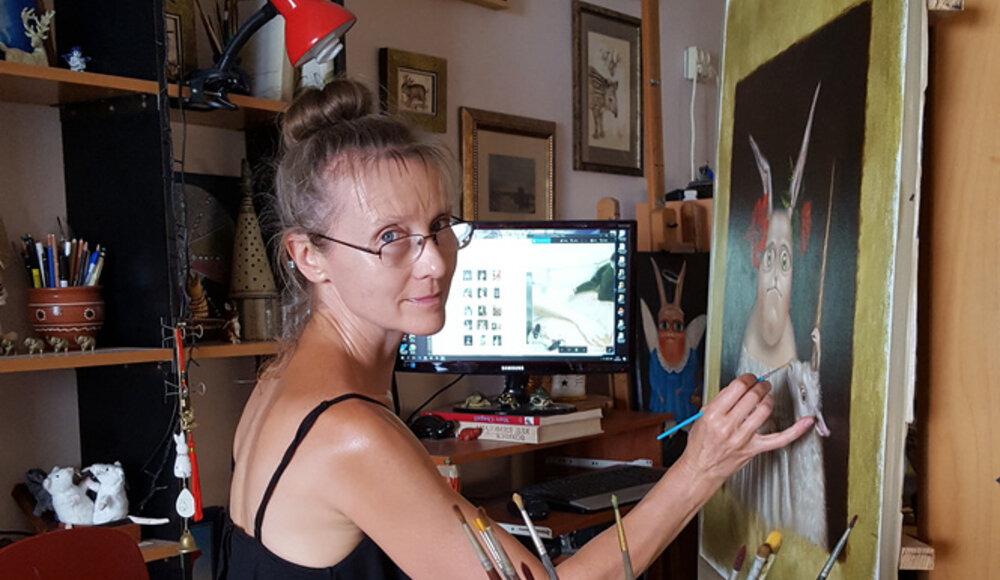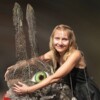What made you approach art and become an artist? (events, feelings, experiences...)
Because several generations of my family had devoted themselves to art, absolutely everything in my home environment contributed to my creative development from early childhood.
What is your artistic journey, techniques and subjects you have experimented with to date?
Like most artists, I sought my own path in art. First and foremost, for me, it was about finding a subject that interested me on a personal level. Among my favorite themes is the psychology of human inter-relations, depicted through a prism of the child-like naive perceptions of the world, which, I believe, persist in each of us until the day we die. As for technique, of course, while I was studying art I used a variety of different methods and materials. However, for a number of years now, I’ve preferred to work with acrylic paints, and also use acrylic and watercolor pencils in my graphic work.
What are 3 aspects that differentiate you from other artists, making your work unique?
I can point out two aspects: the first is the image of the primary hero of my paintings, which I created and very much love. The second is my personal style, which combines elements of surrealism with the early Northern Renaissance, along with its inherent mysticism and symbolism.
Each generation of artists builds on the achievements of those that came before, often combining different stylistic trends, or borrowing certain features of this or that style as a means of achieving a particular result. Of course, some artists have tried to completely negate or ignore the artistic achievements of the past, but these attempts generally result in paintings such as the "Black Square".
In my view, it’s important for any artist to create her or his own language in art by synthesizing elements of various preexisting styles. A unique stylistic synthesis is what makes an artist recognizable while at the same time unlike everyone else.
This is a difficult task, achieved by trial and error and honesty with oneself.
Where does your inspiration come from?
The need to draw is a natural state for me.
It begins with whatever happens to be exciting or worrying me at the moment, a kind of response to my inner emotions. The state-designated by the word “inspired”, arises at the moment when the desire to work draws you to the canvas like a magnet.
What is the intent of your art? What visions, sensations or feelings do you want to evoke in the viewer?
The intent of my art is to communicate with people, with the audience.
Art for me is a means of interacting. It’s a language in which I can most accurately convey my worldview.
A way to rouse someone from banal routine, and make him ponder his existence through sensory perception. To give him or her the opportunity to experience a feeling or sense that he might have never encountered in his life. It’s an attempt to help someone see beauty, light, and hope in our not uncomplicated world.
What is the process of creation of your works? Spontaneous or with a long preparatory process (technique, inspiration from art classics or other)?
The actual idea of the painting may occur spontaneously, but after that, it needs to "ripen" and take shape and form in my mind. Then comes the search and selection of materials for the external visualization of the spontaneous idea.
What techniques do you prefer?If yes, can you explain it?
If the word technique refers to a set of professional means and methods, then for me everything is quite traditional, starting with the preparation of the canvas and ending with the painting being varnished.
If, however, “technique” can be understood as a way to achieve one’s goal, then my technique is to devote as much time to each painting as it requires. To resist the temptation to finish it as quickly as possible.
Are there any innovative aspects to your work? Can you tell us which ones?
I don’t count myself among the innovators. Rather, I am something of a conservator, in the sense that I try to adhere to the painting techniques of the Old Masters.
Do you have a format or medium that you are most comfortable with? If yes, Why?
The format and size of the painting depend on the concept of the piece.
As a rule, the medium is usually canvas.
Where do you produce your work? At home, in a shared or private studio? And within this space how is your production organized?
I adore my house with its open view of a beautiful lake landscape, and my workspace doesn’t require a large area since it only includes an easel, a rack with paints and brushes, and a computer. So I’ve never had the need for a separate studio.
Does your work lead you to travel to meet new collectors, for shows or exhibitions? If so, what do you gain from it?
Yes, of course. This is a part of my work.
Exhibitions, meeting new people, impressions from trips to different countries, all of this creates a huge boost of energy, and is an important part of an artist's profession.
How do you imagine the evolution of your work and your figure as an artist in the future?
The true work of any creative person, in my opinion, consists of the continuous perfecting of their technique. Not for technique’s sake, but rather to improve the possibility of a clearer and more accurate display of artistic intent.
The uniqueness of a specific work of art lies in its originality and irreplaceability.
Had it not been discovered by Newton, the law of universal gravitation would have been discovered by another scientist sooner or later.
Whereas, a particular painting, sculpture, musical or literary work, had it not been created by its author, would never have been created by anyone else!
Since the underlying theme in my work is not of a transitory nature, I hope that in the future it will still resonate in people’s hearts.
What is the topic, style, or technique of your latest artistic production?
My last painting, "Vesper", is the continuation of a series from my previous work.
I’d rather not verbalize the topic so as not to impose my intended meaning of the piece on the viewer.
For me, the viewer is akin to a musician interpreting a composer's work. Let everyone choose his or her own interpretation.
Can you tell us about your most important exhibition experience?
As I’ve already said, exhibitions are an important part of an artist's life.
It’s been my experience that an essential feature of any exhibition is the opportunity for feedback. The chance to directly interact with the viewers. In my opinion, it’s unfortunate that many artists neglect to utilize this very meaningful opportunity.
If you could have created a famous work in the history of art, which one would you choose? And why would you choose it?
I would have chosen Memling’s Diptych with the Allegory of True Love.
Mainly because Memling is my favorite artist. He managed to achieve that which I am always striving toward. And the reason that I would choose this particular piece, is because I see a kind of magic in it, a mystery that fascinates me.
If you could invite a famous artist (dead or living) to dinner, who would it be? How would you propose him/her to spend the evening?
Memling, of course. I would try to keep his wine glass full at all times so that he would drunkenly spill his professional secrets to me.
And, if I could persuade him to let me sit silently behind him while he paints, I would be overjoyed.
Can you try to explain what lies behind your figurative investigation?
For me, as an artist working in a realistic style, the depiction of a person is related to the specifics of his or her gender, age, and the time and location of the character in the painting. These conditions, however, stood in the way of my desire to depict a person’s psyche, or psychological state, through the use of symbolic imagery meant to affect the viewer on a subconscious level.
The contradiction between the desire for realism, on the one hand, and the conveyance of universal psychological traits inherent in a person throughout the entirety of his development, on the other, made me search for a character that allows me to bypass the limitations associated with realism, without breaking away from the style itself. Ancient Egyptian images of half-man - half-animal inspired me to look for the image I needed in that direction. While researching the role of animals in human culture, I discovered that the hare often appears as a character in the fairy tales and myths of many different cultures and people, spanning from America to the Far East, as well as from Africa to Europe. In mythology, the hare is connected to the moon, the sky, and the sun. Its image can be found on ancient ceramics, coins, hieroglyphs, and in folk epics. What appealed to me the most, was that in these fairy tales and myths the hare often embodies both the masculine and the feminine, while also personifying all the qualities and flaws of human nature.
I like to call my paintings “Philosophical Fairy-Tales for Adults”.
I use animal imagery to describe people and, naturally, the relationship between men and women.
After all, we’ve all got a bit of the animal in us…
My “Pyramid” series is an expression of a philosophical and spiritual concept that reflects the balance of opposing forces in a person's life. Every element in each painting is both a symbol and a hint. For example, a bird symbolizes spirituality, while a key is an answer to a question.
My paintings emphasize the human desire for harmonious development. All elements of the painting are interconnected by the author’s overall concept. However, each viewer can find his or her own version of how these elements relate to one another.








 Olimpia Gaia Martinelli
Olimpia Gaia Martinelli












